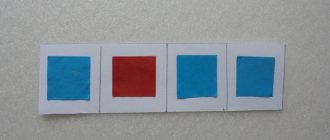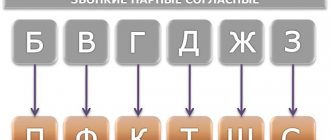Article:
A child’s first acquaintance with sounds and letters occurs in the elementary grades. By that time, the baby can already speak, but does not yet understand what his speech consists of. Many parents teach preschoolers at home. It is quite easy for a child to explain what the difference between vowels and consonants is, but the differences between hard and soft sounds are not so easy for everyone. We offer several popular teaching methods that will help your child learn to understand this issue in a playful way.
Before you start learning, you must explain to your baby what the different organs of the nasopharynx are, which must be used to pronounce certain sounds.
Hard and soft consonants
How to teach a child to distinguish soft sounds from hard ones? We must start with the fact that softness and hardness are characteristics only for consonant sounds. The vowels here are in the chorus. Although hardness and softness are not typical for them, it is their close proximity in some words that can affect these properties of consonant sounds. The main difference between soft and hard sounds is the peculiarities of their pronunciation.
If a person pronounces soft consonant sounds, then the middle of his tongue rises to the palate and blocks the passage through which the air moves, and the tip moves slightly forward towards the teeth. This is additional articulation. The process itself is called palatalization.
Kids don’t need to know such complexities, but parents may find this term useful to broaden their horizons. This does not happen when pronouncing solid sounds.
To understand the difference yourself, it is enough to say a test word in which the same sound acts as a hard and soft sound.
Let's take "break" as an example. Pronunciation of the first consonant sound [p'] makes the tongue dance in the mouth and rise to the sky, but for the second consonant sound [p] these somersaults are not needed.
It’s easy for parents to understand the difference, but how can you explain it to a child? We suggest using your imagination and using interesting stories, cheat sheets and simple games that will help kids remember hard and soft consonant sounds.
Setting the sound P in stages
Lip exercises
- "Smile".
Smile so that the upper and lower teeth are visible and hold this position for 5-7 seconds. - "Tube".
Stretch your lips with a tube: 1st option - pronounce the sound [U] for a long time without using your voice; 2nd option - pull your lips slightly forward, as if forming a square; teeth are closed. - "The doors are opening." Slowly open your mouth until there is a distance of 10-15 mm between the upper and lower teeth, hold your lips in the “Smile” position.
Tongue exercises
Particular attention should be paid to exercises to control the muscles of the tongue. "Pancake." Place a wide, relaxed tongue on the lower lip. Make sure that the lower lip is not pulled over the teeth, and the upper teeth are also not covered by the upper lip (that is, the “Smile” position is maintained). If the tongue does not take the desired shape, pronounce the syllables “ba-ba-ba” with your tongue sticking out between your lips. Upon achieving success, make the tongue wide without pronouncing these syllables and blow until a groove is formed along the midline of the tongue.
- “Whose teeth are cleaner?”
Open your mouth slightly and use the tip of your tongue to “brush” the inside of your upper teeth, moving your tongue from side to side. - "Kitty."
Bend the wide tip of the tongue up towards the nose. If this movement does not work, then you should first practice licking the upper teeth under the lip from right to left, then licking the upper lip. - "Painter".
Smile, open your mouth and stroke the hard palate with the tip of your tongue, moving your tongue back and forth. - “Swing”
(inside the mouth). Bend the wide tip of the tongue alternately up and down between the teeth, gradually pulling it into the depths of the mouth. All movements should be done slowly, clearly, rhythmically with a mental count of “one-two” (up), “one-two” (down), etc., gradually accelerating the pace in subsequent sessions. - "Horse".
Click the tip of your tongue. Suck the tip of your tongue to the front edge of the roof of your mouth and tear it off, opening your mouth wide. - "Mushroom".
Lips in the “Smile” position, teeth open. Suck the front of your tongue to the hard palate. Holding the tongue in this position, connect and open the teeth until slight pain appears in the area of the hypoglossal ligament. - "Machine gun".
Smile, open your mouth and tap the tip of your tongue behind your upper teeth, repeatedly and clearly pronouncing the sound [D]: “d-d-d.” First pronounce the sound [D] slowly, then gradually speed up the tempo. - "The plane is buzzing."
Lips in the “Smile” position, the upper and lower teeth are visible, open by 10-15 mm. The wide tip of the tongue behind the upper teeth. Pronounce the sounds [Z] or [Zh] (you should get a sound reminiscent of the roar of a motor). Important: The lateral edges of the tongue should be pressed against the molars, the tip of the tongue should be thin and mobile, the lips should not be rounded.
If the child does not succeed in the “The plane is buzzing” exercise for a long time, then you can lift his tongue by the upper teeth with your fingers or a spatula. In this case, the child must pronounce “j-z-z-z” for a long time.
How to teach a child to distinguish sounds
Children perceive information best if it is presented in a playful way. Together with your child, come up with an interesting story that will help explain the complex relationship between hard and soft consonant sounds.
Once upon a time, hard and soft sounds lived together. There was no enmity or quarrel between them, until one day an ambitious group of vowels, which included E, Yo, Ya, Yu and I, wanted to gain power over everyone. A war began that lasted for many years. A, O, U, E and S remained neutral and preferred to stay away, because they could not take anyone’s side. The war dragged on, so the vowels decided to use cunning. They turned for help to a soft sign, which does not have its own sound at all, but loves to pit others against each other.
This harmful letter told the vowels about the place where the consonants were hidden, and in return demanded a number of privileges after the successful completion of the military campaign. As a result, the consonants were surrounded. A group of militant vowels gave them an ultimatum and those who agreed had to accept their terms. The war was lost and the winners celebrated their success with pomp.
A small group of vowels received undivided power. Now they determine whether the consonant sound will be soft or hard. The soft sign received exactly the same rights. Now he, too, can push around the vanquished. Although among those who agreed there were also those who did not want to put up with the circumstances. All the hissers, along with a couple of comrades-in-arms, did not raise the white flag and went to partisans in the forests. The compliant consonants now strictly obey the laws of the vowels, and a few rebels continue to carry out sabotage activities, although without much results.
This simple story clearly demonstrates the peculiarities of the relationship between vowels and consonants. The names of the rebels that we will mention later should be immediately blacklisted. They are still wanted by the vowels for their disobedience. A "Wanted" sign can be placed on the refrigerator or near your little student's desk.
This hint should be constantly in front of the child’s eyes. The remaining consonants, which submitted to the victors, are now forced to become either soft or hard depending on their neighbors. If they are followed by the vowels E, E, I, Yu, I or b, then they become soft because they lose their will in front of the winners. If another vowel (A, O, U, E or Y) or consonant lands on their tail, then they become firm, as they feel support.
Methods for producing the sound R
- If the child successfully copes with all the exercises, you can begin to directly produce the sound P hard and Pb soft, using mechanical assistance: put a rubber pacifier on a wooden spatula and, placing the tongue in the position for the “The plane is buzzing” exercise, make quick oscillatory movements left and right or back and forth under the tip of the tongue until a steady vibration of the tongue is obtained. Staging the sound [P] using a pacifier is easier and faster in a lying position: the child’s head lies on the teacher’s lap. The mechanical method gives the child the opportunity to feel the vibration of the tongue, muscularly imprint it and subsequently reproduce it without mechanical assistance.
- It is sometimes possible to obtain vibration of the tongue using the following technique: place a thick ball of paper (tied to a long thread that the child holds in his hands) on the tip of the tongue, remove the tongue by the upper teeth and blow it off the tongue with a strong air stream. Important: It is necessary to strictly ensure that the child does not inhale the lump of paper.
- Another technique is based on the rapid repetition of the sound [D] in one exhalation, articulated in a special way: the child is asked to pronounce the sound [D] quickly and repeatedly (“dddddddddddd…”) with a half-open mouth (the tip of the tongue at the upper alveoli). The child should see quick strokes of the tip of the tongue in the mirror. The tempo of these beats gradually increases and the tip of the tongue vibrates at different rates. These rhythmic tongue strokes are then combined with vowels in forward and backward order, for example: ddda addd addda dddy yddd ydddy
While the child is performing these exercises, use a spatula placed under the front edge of the tongue to make frequent oscillatory movements, which causes a rumble characteristic of the sound [P] to be heard.
Recording sounds
In transcription, the softness of a consonant sound is indicated by adding the symbol ' to its notation. This is an apostrophe that appears in some loanwords.
For example, to indicate the softness of the sound P in transcription, you need to write [p']. The hardness of the sound is not indicated.
There's nothing complicated about it. Offer your child a simple task. He needs to write out from a group of words only those that contain soft consonants, and then transcribe them with an apostrophe. Just a few of these exercises, and he will quickly remember how softness is indicated.
Guess
We write signs with transcriptions of words. The child’s task is to name the word and name soft sounds. It is best to make the signs bright and large, then it will be more interesting for children to react to them.
To start the game, select easy words: [m`el]; [soap]; [l`uk]; [WHO]. And at the end you can complicate the task and give the following words: [b`elka]; [ski track]; [kl`on].
While playing, the child visually remembers the designation of soft consonant sounds and gains practical skills in using knowledge when writing.
Always hard and soft sounds
Now it’s time to find out the names of those very rebels who did not want to surrender to the enemy without a fight. The sounds Ch, Shch and Y are always soft, but C, Zh, Sh can only be hard. These are six consonant sounds that are still waging their quiet war and do not want to submit to the power of vowels. It doesn't matter who they happen to be next door to. The steadfastness of these sounds is admirable.
Table of hard and soft sounds
All rules are collected in one table. At first glance, it may seem like gobbledygook to a child, but after accessible explanations and careful study, the new material will no longer seem so complicated.
Print and hang this picture in a visible place so that your child can learn these rules at any convenient time.
Voiced and unvoiced sounds
Consonant sounds are also classified into voiced and voiceless. The former consist of voice and noise, while the latter consist only of noise.
The voiced category includes: [B], [G], [D], [F], [Z], [V], [Y], [L], [M], [N], [R].
The deaf group includes: [К], [П], [Х], [Ц], [Ч], [С], [Т], [Ф], [Ш], [Ш].
Most consonants can form pairs based on deafness and hardness:
[B]—[P] [V]—[F] [D]—[K] [D]—[T] [G]—[S] [W]—[W]
Voiceless and voiced consonants are easy to remember using two sentences:
- “The Lion and the Toad Have Many Friends” (Voiced)
- “Styopka, do you want a cheek? - Ugh!" (Deaf).
You can memorize them or print them out on a separate card.
Examples of tasks for children
Tasks for training the differences between paired consonants can be compiled for each pair according to the following principle (using the example of the D/T pair):
Tasks for distinguishing a pair of consonants G/K






